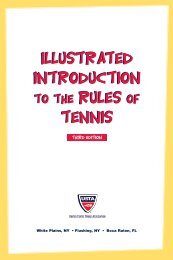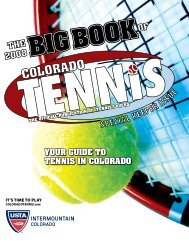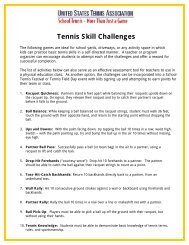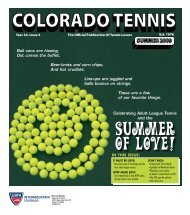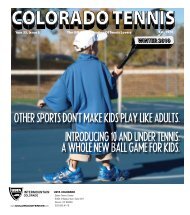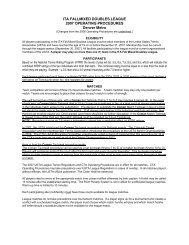NTRP ratings - USTA.com
NTRP ratings - USTA.com
NTRP ratings - USTA.com
You also want an ePaper? Increase the reach of your titles
YUMPU automatically turns print PDFs into web optimized ePapers that Google loves.
70 West Red Oak Lane<br />
White Plains, NY 10604<br />
usta.<strong>com</strong>
1.0<br />
1.5<br />
2.0<br />
National Tennis Rating 2.5 Program (<strong>NTRP</strong>)<br />
Guidebook<br />
3.0<br />
3.5<br />
4.0<br />
4.5<br />
5.0<br />
5.5<br />
6.0<br />
7.0
CONTENTS<br />
THE NATIONAL TENNIS RATING PROGRAM<br />
Introduction ...................................................................................................1<br />
Benefits of the <strong>NTRP</strong> for Teaching Professionals .................................1-2<br />
How to Promote the <strong>NTRP</strong> .................................................................2<br />
How to Implement the <strong>NTRP</strong>.............................................................3<br />
<strong>NTRP</strong> Self-Rating Guidelines .....................................................................3<br />
<strong>NTRP</strong> Clinic: Preparation and Implementation.......................................4<br />
Purpose of an <strong>NTRP</strong> Clinic .................................................................4<br />
Preparation for an <strong>NTRP</strong> Clinic..........................................................4<br />
Conducting the <strong>NTRP</strong> Clinic ..............................................................5<br />
Summary ........................................................................................................5<br />
GENERAL CHARACTERISTICS OF <strong>NTRP</strong> PLAYING LEVELS..............7<br />
SPECIFIC CHARACTERISTICS OF <strong>NTRP</strong> PLAYING LEVELS............8-9<br />
QUESTIONS AND ANSWERS .................................................................10-11<br />
General.......................................................................................................10-12<br />
Age/Rating/Ranking ..............................................................................12-13<br />
Copyright <strong>USTA</strong>, IHRSA, USPTA, 1979<br />
Revised, 1981, 1983, 1985, 1989, 1991, 1993, 1995, 1999, 2002, 2005<br />
Additional materials and publications available from:<br />
United States Tennis Association<br />
70 West Red Oak Lane<br />
White Plains, New York 10604<br />
usta.<strong>com</strong>
INTRODUCTION TO THE <strong>NTRP</strong><br />
In 1978, the United States Tennis Association (<strong>USTA</strong>), in cooperation with<br />
the United States Professional Tennis Association (USPTA) and the International<br />
Health, Racquet and Sportsclub Association (IHRSA), undertook a study of the<br />
many tennis rating systems in existence at that time. Researchers involved in<br />
evaluating the existing systems agreed that a rating program had to be universally<br />
accepted, easy to administer, and non-exclusive in order to be successful.<br />
With this in mind, the <strong>USTA</strong>, USPTA, and IHRSA chose to adopt and<br />
promote the National Tennis Rating Program (<strong>NTRP</strong>), a classification system<br />
that identifies and describes thirteen levels of tennis-playing ability. The<br />
sponsoring organizations reasoned that by standardizing the method of<br />
classifying players throughout the country, players could achieve better<br />
<strong>com</strong>petition, on-court <strong>com</strong>patibility, personal challenge, and enjoyment. The<br />
<strong>NTRP</strong> is also an excellent tool for player placement in group lessons, leagues,<br />
tournaments, and other programs.<br />
To assist in self-rating, a set of guidelines (provided in this booklet) for each<br />
level of play was developed and adopted by the sponsoring organizations as an<br />
official part of the <strong>NTRP</strong>.<br />
In research sponsored by the <strong>USTA</strong>, Graham Neil, Ph.D., McGill University,<br />
Montreal, found that when properly used the <strong>NTRP</strong> is a valid method for<br />
determining a player’s level. He looked at 75 tennis players ranging in age<br />
from 13 to 55. After they rated themselves, he measured their actual level of<br />
<strong>com</strong>petition and found a high correlation between their self-rating and their<br />
actual level of play.<br />
1<br />
BENEFITS OF THE <strong>NTRP</strong> FOR TEACHING PROFESSIONALS<br />
The <strong>NTRP</strong> is one of the most versatile programming tools currently<br />
available to teaching professionals for strengthening their tennis programs,<br />
thereby increasing their revenues while promoting the growth of tennis.<br />
Through a variety of applications, the <strong>NTRP</strong> can increase the number of players<br />
and the enjoyment of those players at private and public facilities of every kind.<br />
Following are some of the ways in which teaching professionals can apply the<br />
<strong>NTRP</strong> to the mutual benefit of these two important causes.<br />
1. The <strong>NTRP</strong> can be used to ensure equitable <strong>com</strong>petition in virtually every<br />
type of league activity including <strong>USTA</strong> League Tennis, corporate leagues,<br />
interclub leagues, and intraclub leagues.<br />
2. The <strong>NTRP</strong> is the perfect equalizer for any recreational tournaments at private<br />
or public facilities that might benefit from level <strong>com</strong>petition. These include<br />
round robins, ladders, men’s, women’s, and mixed doubles tournaments,<br />
adult-child events, and team tournaments.
3. The <strong>NTRP</strong> can be used to put together players of <strong>com</strong>patible playing levels<br />
for group lessons. Maintaining player <strong>com</strong>patibility in group lessons is a major<br />
determinant of a group’s longevity. It also encourages pupils to practice<br />
between lessons<br />
4. The <strong>NTRP</strong> offers an ideal progression around which to plan a tennis<br />
teaching program. The distinction between one <strong>NTRP</strong> level and the next in<br />
regard to basic strokes and strategies makes it an ideal guide for planning<br />
lesson programs.<br />
5. The distinct progression that the <strong>NTRP</strong> provides for lesson programming is<br />
an effective marketing/sales tool for teaching professionals in promoting<br />
their respective lesson programs.<br />
6. <strong>NTRP</strong> <strong>ratings</strong> are a key element in establishing a reliable player bank,<br />
either a manual or <strong>com</strong>puterized listing of available players by level.<br />
7. <strong>NTRP</strong> provides the teaching professional with a tool to encourage non-tennis<br />
players at any facility to make tennis their “second”—if not their first—<br />
sport. Being able to arrange immediate and <strong>com</strong>patible games or lessons for<br />
non-players is a step toward converting those individuals to tennis.<br />
2<br />
8. <strong>NTRP</strong> provides the imaginative tennis professional with a number of ways<br />
to equalize individuals or teams during a match. The difference between two<br />
<strong>NTRP</strong> <strong>ratings</strong> can be used as a means of adding to, subtracting from, or<br />
working off points in order to win a game in any fun set or handicap/<br />
equalization tournament.<br />
9. <strong>NTRP</strong> is tennis’s answer to generating motivational improvement of players.<br />
10. Since it is a universal rating system, the <strong>NTRP</strong> allows teaching professionals<br />
to re<strong>com</strong>mend lesson programs and games to visitors from distant sites.<br />
HOW TO PROMOTE THE <strong>NTRP</strong><br />
Posters, newsletters, newspapers, public announcements, and flyers all can<br />
be used to inform players, parks and recreation departments, and managers of<br />
sports facilities of the benefits of using the <strong>NTRP</strong> in their tennis programs.<br />
Whenever possible the <strong>NTRP</strong> should be used for organized recreational and<br />
<strong>com</strong>petitive activities such as instructional programs, round robins, social<br />
matches, leagues, challenge ladders, inter-club <strong>com</strong>petitions, and tournaments.
HOW TO IMPLEMENT THE <strong>NTRP</strong><br />
The following suggestions are offered to help a facility, CTA (Community<br />
Tennis Association) or sponsoring organization initiate and maintain a successful<br />
<strong>NTRP</strong> rating program:<br />
1. Players should be given sufficient information and resources to be able to rate<br />
themselves, including contact information for assistance. The self-rating<br />
guideline poster should be displayed in a prominent spot as a reference for<br />
participants or mailed to players or distributed at the facility where the <strong>NTRP</strong><br />
is to be used. Facilities can direct players to <strong>USTA</strong>.<strong>com</strong> for <strong>NTRP</strong> characteristics.<br />
2. A qualified person should handle such details as scheduling matches and<br />
keeping accurate records of results.<br />
3. After the <strong>NTRP</strong> is established, a <strong>com</strong>puter program may generate <strong>ratings</strong>,<br />
which are based on match results. The facility or sponsoring organization<br />
should maintain a file of all rated players and keep it up to date as <strong>ratings</strong><br />
change. This facilitates matching players for social or <strong>com</strong>petitive programs.<br />
Once the program is established, maintenance tasks such as updating the file<br />
be<strong>com</strong>e routine, but they do require time and effort.<br />
<strong>NTRP</strong> SELF-RATING GUIDELINES<br />
The <strong>NTRP</strong> describes the general characteristics that tennis players exhibit in each<br />
of thirteen skill levels. Depending on your <strong>com</strong>petitive ability and other factors,<br />
you may find that you actually play above or below the category that best<br />
describes your skill level. The category you choose is not meant to be permanent,<br />
but can be adjusted as your skills change or as your match play demonstrates<br />
the need for reclassification. Ultimately, your rating is based upon match results.<br />
With these caveats in mind, the following provides general guidelines for selfrating<br />
and then for checking the probable accuracy of your self-rating.<br />
3<br />
To place yourself in an <strong>NTRP</strong> skill level:<br />
1. Begin with 1.0. Read the descriptions of all the general characteristics carefully<br />
and then decide which one best describes your present tennis-playing ability.<br />
2. Assume you are <strong>com</strong>peting against players of the same gender and ability<br />
level.<br />
3. If in doubt, place yourself in the next highest level.<br />
To check your self-rating:<br />
After choosing a playing level, ask yourself:<br />
“Can I play <strong>com</strong>petitively against any age player of my gender<br />
who is rated at the same level that I have rated myself”<br />
If your answer is “yes,” your self-rating is probably accurate.
<strong>NTRP</strong> CLINIC: PREPARATION AND IMPLEMENTATION<br />
Purpose of an <strong>NTRP</strong> Clinic<br />
There are a number of reasons to hold an <strong>NTRP</strong> Clinic, including<br />
the following:<br />
1. To promote the use of the <strong>NTRP</strong> as an effective means of<br />
classifying tennis players according to their skill levels.<br />
2. To demonstrate the use of the <strong>NTRP</strong> as a self-rating procedure.<br />
3. To generate increased interest in tennis programs and services<br />
available at local facilities and clubs.<br />
Preparation for an <strong>NTRP</strong> Clinic<br />
To conduct an <strong>NTRP</strong> clinic, you will need the following materials:<br />
• National Tennis Rating Program (<strong>NTRP</strong>) Guidebook, revised 2005<br />
• National Tennis Rating Program Poster<br />
Study the <strong>NTRP</strong> Guidebook. Be certain you are thoroughly familiar with all<br />
thirteen skill levels. Once you are, take the following steps:<br />
4<br />
1. Decide how long the <strong>NTRP</strong> clinic will be—one afternoon, an entire day, a<br />
weekend, or one week. Then decide on the specific day or days and the hours<br />
during which the clinic will be held. Allow sufficient preparation and oncourt<br />
time so that the <strong>NTRP</strong> event will be successful.<br />
2. Announce the <strong>NTRP</strong> Clinic, including dates, time, and location, well in<br />
advance to ensure maximum <strong>com</strong>munity participation.<br />
3. In order to be able to estimate the number of participants and thereby prepare<br />
most efficiently for your clinic, provide an opportunity for pre-registration.<br />
Then organize the <strong>NTRP</strong> clinic to suit the expected number of participants.<br />
Remember: Effective self-<strong>ratings</strong> are best ac<strong>com</strong>plished when players can be<br />
matched with other players of similar ability.
CONDUCTING THE <strong>NTRP</strong> CLINIC<br />
Design your <strong>NTRP</strong> clinic so that it is both effective and enjoyable. As people arrive,<br />
greet them in a friendly manner and introduce yourself. Ask them to introduce<br />
themselves to each other. Have the <strong>NTRP</strong> poster prominently displayed so that<br />
it’s a focal point of discussion for early arrivers.<br />
The following suggestions have been shown to be effective in running a<br />
successful <strong>NTRP</strong> clinic:<br />
1. Briefly describe the thirteen skill levels and self-rating procedures of the<br />
<strong>NTRP</strong>. Explain the purpose of the <strong>NTRP</strong>.<br />
2. Before assigning players to a court, have them review the <strong>NTRP</strong> poster.<br />
Then have them rate themselves. Answer questions and guide participants<br />
through the self-rating process.<br />
3. Group players of similar ability for singles and doubles play.<br />
4. Have each group play a minimum of four no-ad games and a tie-break while<br />
a professional observes their on-court performance. (Allow a half hour<br />
minimum for each group.) If necessary, revise their self-<strong>ratings</strong> based on<br />
what the professional observes during clinic play.<br />
5. Keep a <strong>com</strong>plete record of all players who participate in the <strong>NTRP</strong> clinics<br />
along with their <strong>ratings</strong>. Let players know that the initial self-rating is a<br />
suggested entry level for league, tournament, or facility participation.<br />
5<br />
SUMMARY<br />
The National Tennis Rating Program was developed because of the conviction<br />
that players will get more enjoyment from the game of tennis if they are more<br />
evenly matched by skill level and that the best way to achieve this is through<br />
a universally accepted standardized rating program that is easy to administer.<br />
The <strong>NTRP</strong> achieves these goals. The <strong>NTRP</strong> is evaluated annually and<br />
modifications are made as necessary to ensure its ongoing quality.<br />
The following pages present first the general characteristics of the thirteen<br />
<strong>NTRP</strong> playing levels and then more details for each of the playing levels, which<br />
can be used for verification purposes. These guidelines are followed by a list of<br />
<strong>com</strong>monly asked questions and their answers regarding the <strong>NTRP</strong>.
GENERAL CHARACTERISTICS OF <strong>NTRP</strong> PLAYING LEVELS<br />
Players in wheelchairs should use these same General Characteristics<br />
to determine their <strong>NTRP</strong> skill level. The only difference observed is<br />
mobility and power on the serve. (For more details concerning<br />
characteristics, see pages 8-9.<br />
1.0 This player is just starting to play tennis.<br />
1.5 This player has limited experience and is still working primarily on getting<br />
the ball into play.<br />
2.0 This player needs on-court experience. This player has obvious stroke<br />
weaknesses but is familiar with basic positions for singles and doubles play.<br />
2.5 This player is learning to judge where the ball is going, although court<br />
coverage is weak. Can sustain a short rally of slow pace with other players<br />
of the same ability.<br />
3.0 This player is fairly consistent when hitting medium-paced shots, but is not<br />
<strong>com</strong>fortable with all strokes and lacks execution when trying for directional<br />
control, depth, or power. Most <strong>com</strong>mon doubles formation is one up, one back.<br />
3.5 This player has achieved improved stroke dependability with directional<br />
control on moderate shots, but still lacks depth and variety. This player<br />
exhibits more aggressive net play, has improved court coverage, and is<br />
developing teamwork in doubles.<br />
7<br />
4.0 This player has dependable strokes, including directional control and depth<br />
on both forehand and backhand sides on moderate shots, plus the ability to<br />
use lobs, overheads, approach shots, and volleys with some success. This<br />
player occasionally forces errors when serving. Rallies may be lost due to<br />
impatience. Teamwork in doubles is evident.<br />
4.5 This player has begun to master the use of power and spins and is beginning<br />
to handle pace, has sound footwork, can control depth of shots, and is<br />
beginning to vary game plan according to opponents. This player can hit first<br />
serves with power and accuracy and place the second serve. This player<br />
tends to overhit on difficult shots. Aggressive net play is <strong>com</strong>mon in doubles.<br />
5.0 This player has good shot anticipation and frequently has an outstanding shot<br />
or attribute around which a game may be structured. This player can regularly<br />
hit winners or force errors off of short balls and can put away volleys, can<br />
successfully execute lobs, drop shots, half volleys, overhead smashes, and<br />
has good depth and spin on most second serves.<br />
5.5 This player has developed power and/or consistency as a major weapon. This<br />
player can vary strategies and styles of play in a <strong>com</strong>petitive situation and hits<br />
dependable shots in a stress situation.<br />
6.0 to 7.0 The 6.0 player typically has had intensive training for national<br />
tournament <strong>com</strong>petition at the junior and collegiate levels and has obtained a<br />
sectional and/or national ranking. The 6.5 and 7.0 are world-class players.
1.0<br />
1.5<br />
2.0<br />
2.5<br />
VERIFICATION GUIDELINES<br />
FOREHAND BACKHAND SERVE/RETURN OF SERVE<br />
This player is just starting to play tennis.<br />
This player has limited experience and is still working primarily on getting the ball into play.<br />
In<strong>com</strong>plete swing;<br />
lacks directional intent<br />
Form developing; prepared for<br />
moderately paced shots<br />
Avoids backhands; erratic<br />
contact; grip problems;<br />
in<strong>com</strong>plete swing<br />
Grip and preparation problems;<br />
often chooses to hit forehand<br />
instead of backhand<br />
In<strong>com</strong>plete service motion; double<br />
faults <strong>com</strong>mon; toss is inconsistent;<br />
return of serve erratic<br />
Attempting a full swing; can get the<br />
ball in play at slow pace; inconsistent<br />
toss; can return slow-paced serve<br />
3.0<br />
3.5<br />
Fairly consistent with some<br />
directional intent; lacks depth<br />
control<br />
Improved consistency and<br />
variety on moderate shots with<br />
directional control; developing<br />
spin<br />
Frequently prepared; starting<br />
to hit with fair consistency on<br />
moderate shots<br />
Hits with directional control on<br />
moderate shots; has difficulty on<br />
high or hard shots; returns<br />
difficult shots defensively<br />
Developing rhythm; little consistency<br />
when trying for power; second serve<br />
is often considerably slower than<br />
first serve; can return serve with fair<br />
consistency<br />
Starting to serve with control and<br />
some power; developing spin; can<br />
return serve consistently with<br />
directional control on moderate<br />
shots<br />
4.0<br />
Good consistency; hits with<br />
depth and control on moderate<br />
shots; may try to hit too good a<br />
placement on a difficult shot<br />
Directs the ball with consistency<br />
and depth on moderate shots;<br />
developing spin<br />
Places both first and second serves,<br />
often with power on first serve; uses<br />
spin; dependable return of serve; can<br />
return with depth in singles and mix<br />
returns in doubles<br />
4.5<br />
5.0<br />
Very good consistency; uses<br />
speed and spin effectively;<br />
controls depth well; tends to<br />
overhit on difficult shots;<br />
offensive on moderate shots<br />
Strong shots with control, depth,<br />
and spin; uses forehand to set up<br />
offensive situations; has<br />
developed good touch;<br />
consistent on passing shots<br />
Can control direction and depth<br />
but may break down under<br />
pressure; offensive on moderate<br />
shots<br />
Can use backhand as an<br />
aggressive shot with good<br />
consistency; has good direction<br />
and depth on most shots;<br />
varies spin<br />
Aggressive serving with limited<br />
double faults; uses power and spin;<br />
developing offense; on second serve<br />
frequently hits with good depth and<br />
placement; frequently hits aggressive<br />
service returns; can take pace off<br />
with moderate success in doubles<br />
Serve is placed effectively with<br />
intent of hitting to a weakness or<br />
developing an offensive situation;<br />
has a variety of serves to rely on;<br />
good depth, spin, and placement on<br />
most second serves to force weak<br />
return or set up next shot; can mix<br />
aggressive and off-paced service<br />
returns with control, depth, and spin<br />
5.5<br />
6.0<br />
to<br />
7.0<br />
This player is capable of hitting dependable shots in stress situations; has developed good anticipation;<br />
can pick up cues from such things as opponent's toss, body position, backswing, preparation; first and<br />
second serves can be depended on in stress situations and can be hit offensively at any time; can analyze<br />
and exploit opponent's weaknesses; can vary strategies and style of play in a <strong>com</strong>petitive situation.<br />
These players will generally not need <strong>NTRP</strong> <strong>ratings</strong>. Rankings or past rankings will speak for themselves.<br />
The 6.0 player typically has had intensive training for national tournament <strong>com</strong>petition at the junior level<br />
and collegiate levels and has obtained a sectional and/or national ranking. The 6.5 player has a reasonable<br />
chance of succeeding at the 7.0 level and has extensive satellite tournament experience. The 7.0 is a worldclass<br />
player who is <strong>com</strong>mitted to tournament <strong>com</strong>petition on the international level and whose major<br />
source of in<strong>com</strong>e is tournament prize winnings.
Specific Characteristics of Various Playing Levels<br />
VOLLEY SPECIAL SHOTS PLAYING STYLE<br />
Reluctant to play net; avoids<br />
backhand; lacks footwork<br />
Un<strong>com</strong>fortable at net especially on<br />
the backhand side; frequently uses<br />
forehand racquet face on backhand<br />
volleys<br />
Consistent forehand volley; inconsistent<br />
backhand volley; has trouble<br />
with low and wide shots<br />
More aggressive net play; some<br />
ability to cover side shots; uses<br />
proper footwork; can direct forehand<br />
volleys; controls backhand<br />
volley but with little offense;<br />
difficulty in putting volleys away<br />
Depth and control on forehand<br />
volley; can direct backhand volleys<br />
but usually lacks depth; developing<br />
wide and low volleys on both sides<br />
of the body<br />
Can handle a mixed sequence of<br />
volleys; good footwork; has depth<br />
and directional control on<br />
backhand; developing touch; most<br />
<strong>com</strong>mon error is still overhitting<br />
Can hit most volleys with depth,<br />
pace and direction; plays difficult<br />
volleys with depth; given<br />
opportunity volley is often hit for<br />
a winner<br />
Can lob intentionally but with<br />
little control; can make contact<br />
on overheads<br />
Can lob fairly consistently on<br />
moderate shots<br />
Consistent overhead on shots<br />
within reach; developing approach<br />
shots, drop shots, and half volleys<br />
Can put away easy overheads;<br />
can poach in doubles; follows<br />
aggressive shots to the net; beginning<br />
to finish point off; can hit to<br />
opponent's weaknesses; able to<br />
lob defensively on difficult shots<br />
and offensively on set ups<br />
Hits approach shots with good<br />
depth and control; can consistently<br />
hit volleys and overheads to end<br />
the point<br />
Approach shots and passing<br />
shots are hit with pace and high<br />
degree of effectiveness; can lob<br />
offensively; overhead can be hit<br />
from any position; hits mid-court<br />
volleys with consistency<br />
Familiar with basic positions for<br />
singles and doubles play; frequently<br />
out of position<br />
Can sustain a short rally of slow<br />
pace; modest consistency; weak<br />
court coverage; usually remains in<br />
the initial doubles position<br />
Fairly consistent on medium-paced<br />
shots; most <strong>com</strong>mon doubles<br />
formation is still one up, one back;<br />
approaches net when play dictates<br />
but weak in execution<br />
Improved consistency on moderate<br />
shots with directional control;<br />
improved court coverage; starting to<br />
look for the opportunity to <strong>com</strong>e to<br />
the net; developing teamwork in<br />
doubles<br />
Good consistency on ground strokes<br />
with directional control and depth<br />
demonstrated on moderate shots;<br />
not yet playing good percentage<br />
tennis; teamwork in doubles is<br />
evident; rallies may still be lost due<br />
to impatience<br />
Very good consistency; more intentional<br />
variety in game; is hitting with<br />
more pace; covers up weaknesses<br />
well; beginning to vary game plan<br />
according to opponent; aggressive<br />
net play is <strong>com</strong>mon in doubles; good<br />
anticipation; beginning to handle pace<br />
Frequently has an outstanding shot,<br />
consistency, or attribute around which<br />
game is built; can vary game plan<br />
according to opponent; this player is<br />
“match wise,” plays percentage tennis,<br />
and “beats himself or herself” less<br />
than the 4.5 player; solid teamwork in<br />
doubles is evident; game breaks down<br />
mentally and physically more often<br />
than the 5.5 player<br />
Players in Wheelchairs:<br />
Players in wheelchairs should use these general characteristics to determine their <strong>NTRP</strong> skill level. The only<br />
differences are as follows: Mobility: While players in wheelchairs may have skills that would normally provide<br />
them a certain rating, the mobility factor suggests that when <strong>com</strong>peting against able-bodied players, they<br />
should participate at an <strong>NTRP</strong> skill level that provides for <strong>com</strong>petitive rather than <strong>com</strong>patible play. Serving<br />
ability: Due to the nature of the player’s injury or disability, a powerful serve may not be possible. In this<br />
case, it may be more realistic to self-rate below 4.0, as service strength be<strong>com</strong>es key beyond this level.<br />
Many tournament players in wheelchairs have already received an <strong>NTRP</strong> rating. Wheelchair players should<br />
check with players whose skills match their own before determining their rating. The very best world-class<br />
players in wheelchairs have an <strong>NTRP</strong> rating in the low 4.5s.
QUESTIONS AND ANSWERS<br />
Following are some of the most <strong>com</strong>mon questions asked about the<br />
<strong>NTRP</strong> and answers to these questions. If you would like additional<br />
information on the <strong>NTRP</strong> program and how it can be used in local<br />
programs, please visit usta.<strong>com</strong>, select USA League Tennis, and then<br />
select <strong>NTRP</strong> on the drop-down menu.<br />
General Topics<br />
Q. How do the <strong>NTRP</strong> classifications <strong>com</strong>pare to the traditional terms<br />
“beginner,” “advanced beginner,” “intermediate,” etc. or the frequently<br />
used letters a, b, c, aa, bb, aaa, etc.<br />
A. The <strong>NTRP</strong> was designed to eliminate the use of traditional terms in<br />
classifying player ability. There is so much ambiguity associated with<br />
these systems that translation is difficult. In various parts of the<br />
country, for example, “A” or “Advanced” is the top level of play,<br />
while in other places “AAA” is the best. In general terms, a “D” player<br />
would be a 2.5 and below; a “C” player would be a 2.6-3.5; a “B”<br />
player would be a 3.6-4.5; an “A” player would be a 4.6-5.0; an open<br />
player would be a 5.1 and above.<br />
10<br />
Q. How do players enter the <strong>USTA</strong> League Tennis program<br />
A. New players self-rate using the General and Specific Characteristics<br />
of <strong>NTRP</strong> Playing Levels.<br />
Q. Should players rate themselves as singles players, doubles players, or both<br />
A. Players should rate themselves based on their overall tennis ability.<br />
However, players who are stronger at either singles or doubles<br />
should base their rating on the stronger game.<br />
Q. Can the <strong>NTRP</strong> be successful as a self-rating-only program<br />
A. A self-rating can be accurate. But it is important to remember that<br />
there is no substitute for match results as a measure of playing<br />
ability. Even when the <strong>NTRP</strong> is used as a self-rating-only program,<br />
a tennis professional can assist players through the process. In any<br />
<strong>com</strong>petitive program, it will be<strong>com</strong>e obvious from match results<br />
when players have rated themselves inaccurately.<br />
Q. Can existing leagues, challenge ladders, and other <strong>com</strong>petitive programs be<br />
used in implementing the <strong>NTRP</strong> at a facility<br />
A. Yes. These programs are beneficial in implementing the <strong>NTRP</strong>,<br />
because the match results can be used to assist in self-rating.
Q. Can the <strong>NTRP</strong> self-rating system be used for placement in instructional<br />
programs<br />
A. Yes. The self-rating program can easily be used in instructional<br />
programs. If players incorrectly rate their ability levels, it will show<br />
up in class performance. It is the responsibility of the instructor to<br />
help players adjust their <strong>ratings</strong> and place them at proper class levels.<br />
Q. Is there a prescribed “test” that players can use to rate themselves<br />
A. No. There is no specific test that players should use to determine<br />
their self-rating. The best criteria is match results, but it is helpful to<br />
refer to the <strong>NTRP</strong> self-rating guidelines as well as consider their tennis<br />
history, the <strong>NTRP</strong> <strong>ratings</strong> of friends they play, athletic background,<br />
and how much they might improve in one year.<br />
Q. Must players qualify on all points of all preceding <strong>NTRP</strong> descriptions<br />
before placing themselves in a particular category<br />
A. No. The rating categories are generalizations about skill levels. They<br />
should place themselves in the category that most closely matches<br />
their playing skill level. The ultimate test is in match play results.<br />
Q. Can a player with an obvious stroke deficiency be rated at the same level,<br />
or higher, as a player who has no such deficiency<br />
A. Yes. Some players, for example, cannot hit topspin backhands but<br />
have certain abilities that enable them to play <strong>com</strong>petitively with<br />
players who can do so. A player’s <strong>com</strong>petitive record is the best test<br />
of his or her rating.<br />
11<br />
Q. Does the <strong>NTRP</strong> rate men and women on the same scale<br />
A. The <strong>NTRP</strong> is used to rate both men and women, but men’s and<br />
women’s <strong>ratings</strong> are not intended to be equivalent. When rating<br />
themselves, players should use players of the same gender as<br />
reference points. However, for those individuals wishing to <strong>com</strong>pete<br />
against players of the opposite gender, the following can be used as<br />
a guide. At approximately the 3.5 rate for a man, a woman with a 4.0<br />
rating will be <strong>com</strong>petitive. When a man reaches the 5.0 level or<br />
above, a woman needs to be approximately 1.0 higher in order to<br />
be <strong>com</strong>petitive.<br />
Q. Is it possible to use gradations smaller than .5 in rating players<br />
A. Yes. In fact, the <strong>USTA</strong> <strong>NTRP</strong> <strong>com</strong>puter program <strong>ratings</strong> are calculated<br />
to 100th of a point. It is re<strong>com</strong>mended, however, that for self-rating,<br />
players use the .5 increments, which closely follow the available<br />
tennis levels.
Q. What does it mean to be “<strong>com</strong>petitive” with another player<br />
A. A “<strong>com</strong>petitive” match is one in which the out<strong>com</strong>e is unpredictable<br />
(scores such as 6-4, 6-4 or closer). When one player consistently wins<br />
with only the occasional loss of a few games, the match is not<br />
“<strong>com</strong>petitive.” Properly rated, players within .2 of each other should<br />
be <strong>com</strong>petitive in playing ability.<br />
Q. What does it mean to be “<strong>com</strong>patible” with another player<br />
A. Players with up to a .5 difference in <strong>ratings</strong> are generally considered<br />
“<strong>com</strong>patible.” At a .5 difference in <strong>ratings</strong>, the out<strong>com</strong>e is predictable,<br />
with the higher-rated player winning routinely. “Compatible” players<br />
however, can offer each other recreational, social, and practical<br />
benefits.<br />
Q. Can a player’s rating change<br />
A. In a dynamic environment, a player’s rating changes with every match.<br />
However, rating adjustments will be made during the season only if<br />
the <strong>com</strong>puter evaluates the player to be clearly above the level at<br />
which he or she is currently playing.<br />
12<br />
Age/Rating/Ranking<br />
Q. What is the relationship between ranking and rating<br />
A. Ranking is based upon achievement in sanctioned tournaments, many<br />
of which are based on age divisions. Rating is based on match results,<br />
tennis background, and the <strong>NTRP</strong> self-rating guidelines.<br />
Q. How should individuals rate themselves if they are formerly ranked players<br />
who have not played much in recent years or who have had a permanent<br />
injury<br />
A. A person’s rating should be closely related to his or her potential upon<br />
resuming play on a regular basis. Ratings will not be downgraded<br />
because of layoffs or temporary injuries, but only for permanent<br />
injuries or aging debilities.<br />
Q. How does age enter into the <strong>NTRP</strong> <strong>ratings</strong><br />
A. The <strong>NTRP</strong> is not based on age divisions. All players of the same gender,<br />
regardless of age, should be used as reference points in determining<br />
player <strong>ratings</strong>. After choosing a rating, players should ask themselves:<br />
“Can I play <strong>com</strong>petitively against any age player of my gender who is<br />
rated at the same level that I have rated myself”
Q. Can junior players use the <strong>NTRP</strong> to self-rate<br />
A. Yes. If junior players participate in an adult activity using the <strong>NTRP</strong>,<br />
their <strong>ratings</strong> are in <strong>com</strong>parison to all other players of the same gender<br />
of any age—not just other junior players. Junior players should not<br />
rate themselves until they are experienced in match play.<br />
Q. How does mobility, age, <strong>com</strong>petitive experience and fitness affect your rating<br />
A. Mobility: Ability to cover the courts is a prime factor in <strong>com</strong>petitive<br />
success. Mobility is a more important factor in singles than in doubles.<br />
Age and Competitive Experience: As speed decreases with age, a<br />
player’s <strong>com</strong>petitive ability may be affected. At the same time,<br />
strategy and skills may improve as a player ages. Therefore, one<br />
must rely on <strong>com</strong>petitive results.<br />
Fitness: Temporary changes in fitness such as a non-permanent<br />
injury should not affect a player’s rating. Players whose game and<br />
physical fitness have suffered due to lack of practice and exercise<br />
will not be match tough and should be placed in the category where<br />
they normally <strong>com</strong>pete.<br />
CASE A<br />
A former world-class player, now a 60-and-over senior player, is<br />
interested in a rating. Although once a 7.0, this player is no longer a<br />
7.0. Now his rating will be adjusted according to current match<br />
results and the <strong>NTRP</strong> self-rating guidelines.<br />
13<br />
CASE B<br />
A talented athlete takes up tennis. This player has the potential<br />
to increase his <strong>NTRP</strong> rating dramatically. In this case, skill<br />
development is more important than aging.<br />
Remember:<br />
• The rating categories are generalizations about skill level.<br />
• You may find that you actually play above or below the category that<br />
best describes your skill level, depending on your <strong>com</strong>petitive ability.<br />
• Your self-rating is not meant to be static; rather it may be adjusted as<br />
your match play demonstrates the need for reclassification.<br />
• There is no substitute for match results as a measure of playing<br />
ability.






